Natural Gas Grid
-
- GASTECH 85 Maritime Reporter, Oct 15, 1985 #32
Nice, France—November 12-15 Gastech 85, the International LNG/LPG Conference and Exhibition, will be held November 12-15 at the new Palais des Congres "Acropolis" in Nice, France. This meeting will be the 11th in the very popular series, and the third to be held in France, a country that has played a major role in the international liquefied gas industry.
This year marks the 20th anniversary of the French LNG program. It is appropriate, therefore, that Pierre Alby, president of Gaz de France, will deliver the opening address at the Gastech 85 Conference.
His speech will review French LNG achievements, the present state of the industry, and possible future developments. Gaz de France was the first European gas supply company to lay a natural gas grid and, like British Gas, was a pioneer in the movement of LNG by sea with the Arzew-Le Havre service that began in 1965, making it the world's longest- running LNG import program.
The comprehensive Conference program will feature more than 60 presentations from some 140 authors and panelists in nine sessions.
The session headings are: World Gas Supplies; LPG Production and Trade; Safety and Training; Development of Frontier Gas Fields; Transportation, Technology and Operations; Commercial, Documentation and Contracts; Gases as Transportation Fuels; Liquefied Gas Terminals and Storage; and Technical Developments and Materials.
The Gastech meetings have become the leading gathering place for all who have an involvement in LNG and LPG. National flags from more than 50 participating nations will be displayed on the speakers' platform, and more than 2,000 delegates are expected in Nice for the Gastech 85 meeting.
In addition to the Conference, the Gastech meeting includes a major exhibition of LNG and LPG equipment, technology, and services.
The display areas in the Pal ais des Congres "Acropolis" will be fully occupied by about 100 exhibitors from France, Germany, Japan, the Netherlands, Norway, the U.K., the U.S., and elsewhere, showing the latest advances in engineering for the handling, storage, and transportation of liquefied gases. Many of the stands are part of governmentsponsored or -aided group exhibits from several European nations—an indication of the importance of the exhibition and the quality of the Conference delegates who are the principal visitors to the display areas.
The opening session in the Gastech series is traditionally devoted to World Gas Supplies, and the 1985 meeting is no exception. It will, however, feature for the first time a round table panel discussion on the LNG trades. The impressive gathering of speakers will include: R.A.
Al-Thani, chairman of the executive technical committee responsible for developing Qatar's giant North Field; M.B. Hashim, managing director of Malaysia LNG Sdn. Bhd.; Dr. J.R. McCabe, project coordinator for the North West Shelf Project Coordination Group, Melbourne, Australia; B.
Bramono, head of the gas marketing bureau of Pertamina, Indonesia, the world's largest LNG exporter; M.W.H. Peebles, director of planning at Shell International Gas, and a well-known forecaster and market analyst in the business; and K. Sawamura, manager of Mitsubishi Corporation's LNG project planning team. The panel discussion will be chaired by Alexis Pastuhov, former president of Gazocean USA.
Session two of the Gastech series is traditionally devoted to LPG production and trade; this all-day meeting is widely regarded as the most important LPG gathering held anywhere. Attendance at this session has always been high; this year there is every likelihood that it will be particularly high, as the session is to be chaired by His Excellency Dr.
A.H. Taher, Governor of the General Petroleum and Mineral Organization, Petromin, Saudi Arabia.
Dr. Taher is no stranger to this chair at Gastech; he first led the LPG session at the Gastech 79 meeting in Houston, when Saudi Arabia first entered the LPG business on a very large scale. Since then there have been many fluctuations in the market and in LPG production, and all parties involved in the complex world of LPG take the opportunity offered by the Gastech meetings to attempt to bring some measure of stability to the market.
With Japan as the major buyer and an increasing number of producers anxious to conclude sales deals to make up for the restricted volumes now available from Saudi Arabia (the result of Saudi adherence to OPEC's call for crude cutbacks), the LPG session at Gastech 85 should offer a clear message on where the market is heading in the next 12 months or so.
This year a new session has been introduced to the Gastech program.
Entitled Development of Frontier Gas Fields: the Technological Challenge, its aim is to bring together a number of researchers who are looking beyond exploitation of the current proven gas reserves to the day when engineers will need to seek gas beneath the oceans at depths far beyond the present limits, and from Arctic regions and other frontier areas that in the 21st century will have to be opened for hydrocarbon development.
Led by R. Kvamsdal of the Kvaerner Group, Norway, this panel will include P. Fabiani, deputy manager of advanced technology for Total Exploration-Production, Paris; Prof. K. Kokkinowrachos, professor of ocean engineering at the Technical University of Hamburg-Harburg, and head of the Ocean Engineering Division of the Technical University of Aachen; S.
Yoshii, general director of the technical Research Center of the Japan National Oil Corporation, Tokyo; and J. English, special projects manager of Can-Dive Services Ltd., Vancouver, Canada.
Since 1976, the Gastech meetings have been held in two out of every three years. Beginning in 1986 in Hamburg, the meetings will be held in every even year. The organizers believe that this biennial schedule will more readily meet the needs of both delegates and exhibitors, and provide the right "rhythm" for the industry.
Conference Program Tuesday, November 12 2:00 pm—Official opening ceremony: Welcome from Conference Director followed by official opening address by Pierre Alby, president of Gaz de France.
Session One World Gas Supplies Chairman: E. Rerolle, vice president, Chantiers du Nord et de la Mediterranee.
3:30 pm—"Marketing and the Natural Gas Industry," by B.M.C.
Fogarty, Shell International Gas Ltd., London.
4:00 pm—"Natural Gas: Which Option for Developing Countries— LNG or the Domestic Market?," by J.P. Jonchere, Bureau d'Etudes Industrielles et de Cooperation de l'lnstitut Francais du Petrole.
4:30 pm—"The LNG Trades: Where are they Today and Where are they Going?" A panel discussion by representatives from producers and consumers.
Moderator: Alexis Pastuhov, president, AVP Corporation, Newbury Port, Mass.
Panelists: R.A. Al-Thani, deputy managing director, Qatar General Petroleum Corporation.
M.B. Hashim, managing director, Malaysia LNG Sdn. Bhd.
J.R. McCabe, project coordinator, North West Shelf Project Coordination Group, Melbourne.
B. Bramono, head of Gas Marketing Bureau, Pertamina, Indonesia.
M.W.H. Peebles, director of planning and finance, Shell International Gas Ltd.
K. Sawamura, manager LNG Project Planning Team, Mitsubishi Corporation, Tokyo.
R. Price, director, International Energy Organization & Policy Development, U.S. Department of Energy.
Wednesday, November 13 Session Two LPG Production and Trade Note: This is an all-day session starting at 9:30 am; there will be a luncheon break 12:30-2:00 pm.
Chairman: H.E. Dr. A.H. Taher, Governor, General Petroleum & Mineral Organization, Petromin, Saudi Arabia.
Moderator: S.M. Boushehri, Poten & Partners (UK) Ltd., London.
Speakers: "Production and Marketing Plans of LPG from the North Dome Project," by E. Al-Mutawa, acting head of Marketing & Transport Department, Qatar General Petroleum Corporation.
"The Changing Patterns of Gas Seaborne Trades," by J. Bradley, managing director, P&O Gas Carriers (UK) Ltd., London.
"The Challenging Role for International Traders," by R. Boudet, president, Geogas Enterprise S.A., Geneva.
"The Future of LPG as Ethylene Feedstock," by D. Butters, manager- feedstocks, supply and trading, Imperial Chemicals Industries, U.K.
"The Evolution of LPG Supply and Demand in Japan," by Y. Kanai, international LPG manager, Mitsubishi Corporation, Tokyo.
"LPG Development in Indonesia," by Mr. Kartiyoso, deputy LNG coordinator and LPG coordinator, Pertamina.
"North Sea LPG Supply and Pricing Post-BNOC," by M.G. Peake, manager-LPG trade & supply, BP Gas International, London.
"Exports of LPG from Venezuela," by A. Villasmil, trading manager, Maraven S.A., Caracas.
Panelists: K.R. Al-Oteiba, marketing director, Abu Dhabi National Oil Corporation.
K.A. Harami, manager-sales, Western Hemisphere, Kuwait Petroleum Corporation.
F. Anderiz-Cebrian, director, LPG Supply Department, Butano SA Madrid.
C.E. Bonnet, director-gas, Total Group, Paris.
B. Bramono, head, Gas Marketing Bureau, Pertamina.
F.B. Maple, vice president-corporate planning, Petrolane, Inc., Long Beach, Calif.
M.K. Faid, director-gas exports, Sonatrach, Algeria.
R.J. Foster, general manager-petroleum marketing, Broken Hill Pty. Company, Melbourne.
B.W. Kim, president, Yosu Energy Company, Seoul.
M. Muhammad, general manager, International Marketing Division, Petroliam Nasional Berhad, Malaysia.
T. Nishimura, manager, Product and LPG Acquisitions Section, Idemitsu Kosan, Tokyo.
J.E. Sandvik, senior vice president- refining & marketing, Statoil, Norway.
O. Shaban, manager, International Trade Division, General Petroleum & Mineral Organization, Saudi Arabia.
Session Three Safety & Training Chairman: R.C. Gray, general manager, Society of International Gas Tanker and Terminal Operators Ltd., Bermuda.
10:00 am—"Analysis of the LPG Disaster at San Juan Ixhuatepec, Mexico City, 19 November 1984," by C.M. Pietersen, TNO-Netherlands Organization for Applied Scientific Research, Department of Industrial Safety.
"Burnout Risk Analysis in Gas Storage Plants," bv M. Huther, M.
Zehri, J-P Gilbert, and R. Giribone, Bureau Veritas, France.
"Development Control Around LPG I n s t a l l a t i o n s , " by P.J.
Crossthwaite, health and safety executive, Major Hazards Assessment Unit, U.K.
"Are the Risks in Your Gas Plant Being Properly Managed?" by J.G.
Sellers and C.J. Luck, Arthur D.
Little, Ltd., London.
12:00 noon—Discussion of Papers.
12:30 prn—Luncheon for Delegates.
2:00 pm—"Salvage of Cargo from the War-Damaged 'Gaz Fountain,' " J.A. Carter, Marine Safety Services Ltd., P. & 0. Group, London.
W.J. Yopp, manager, LPG Department, Mobil Corporation, New York.
2:30 pm—"BLEVE Probability of a 100 Te LPG Storage Vessel," by K.W. Blything, Safety and Reliability Directorate, UKAEA. "Thermal Radiation from LNG Trench Fires," by P.A. Croce and K.S.
Mudan, Arthur D. Little, Inc., Cambridge, Mass., and S.J. Wiersma, Gas Research Institute, Chicago- 3:00 pm—Discussion of Papers.
3:30 pm—Coffee Break.
Session Four Development of Frontier Gas Fields: The Technological Challenge Moderator: R. Kvamsdal, Kvaerner Subsea Contracting A/S, Norway.
4:30 pm—Panelists: P. Fabiani, deputy manager-advanced technology, Total Exploration- Production, Paris.
K. Kokkinowrachos, professor of ocean engineering, Technical University of Hamburg-Harburg & Head, West Germany.
S. Yoshii, general manager, Technical Research Centre, Japan National Oil Corporation, Tokyo.
J. English, special projects manager, Can-Dive Services Ltd., Vancouver, B.C.
Thursday, November 14 Session Five Transportation, Technology & Operations Chairmen: R.J. Lakey, Robert J.
Lakey & Associates, Houston; and R.C. Ffooks, consultant, London.
10:00 am—"Design, Construction and Periodical Surveys of Ships for Liquefied Gases—A Classification Society's Viewpoint," by D.
McLean and R.M. Cripps, Lloyd's Register of Shipping, London.
"U.S. Coast Guard Program for New and Existing Liquefied Gas Ships," by K.S. Cook and A.L.
Rowek, U.S. Coast Guard, Washington.
"Time for a Collision-Resistant LPG Carrier Fleet," by F.S. Harris, consultant, U.K.
11:00 am—Discussion of Papers.
12:00 noon—"The LNG/LIN Scheme as a Transport Alternative for Northern Norwegian Gas," J.
Bakke, Kvaerner R&D Division, Norway, and R.S. Heie.rsted, Statoil, Norway.
12:30 pm—Luncheon for Delegates.
French Containment Systems Defined: 2:00 pm—Technical and Economic Aspects of GT LNG Carriers' Containment System Enhanced by High Standardization and Automated Insulation Processess," by R. Lootvoet, Gaz-Transport, France.
"The Low Boil-off Technigaz Membrane System: An Assessment of Safety, Reliability and Operational Economy," by M. Betille and J.M. Lebreton, SN Technigaz, France.
2:30 pm—Discussion of Papers.
3:00 pm—Coffee Break.
J a p a n e s e Developments in LNG Transportation: 3:30 pm—"A New Generation of LNG Carriers for Economy and Operational Flexibility," by R. Ogiwara, T. Yokawa, Y. Kityama, N. Nakano, and M. Shiraha, Kawasaki Heavy Industries Ltd., Kobe.
"Future LNG Carriers," by N.
Umekawa, T. Kobayshi, N.
Ogawa, and T. Akiba, Nippon Kokan K.K., Tokyo.
"Design and Actual Service of Cargo-Handling Equipment on an LNG Carrier," by S. Hata, S. Fukushima, Y. Kobayashi, K. Kawabata, and N. Itoyama, Mitsubishi Heavy Industries Ltd., Tokyo.
"The IHI SPB LNG System- Application of Advanced Al-alloy Welding Technology," by N. lino, K. Minoda, N. Okui, and T. Fujitani, Ishikawajima-Harima Heavy Industries Co. Ltd., Tokyo.
4:30 pm—Discussion of Papers.
Session Six Commercial, Documentation & Contracts Chairman: J.M. Soesan, consultant, U.K.
10:00 am—"Contract Protection of Recoverable Reserves," by E.A.
Massey, Arent, Fox, Kintner, Plotkin & Kahn, Washington, D.C.
"A New Concept for Gas Tankers Operators—Zero Cost Ships," by R.J. Stanclift Jr., consultant, Convent Station, N.J.
" 'LPG Pricetag' and the European Market 1984/5," by K. Potter, consultant, U.K.
11:30 am—Discussion of Papers.
12:30 pm—Luncheon for Delegates.
Session Seven Gases As Transportation Fuels Chairman: T.J. Joyce, T. Joyce Association, Fairfax, Va.
2:00 pm—"TNO's Experience with Natural Gas and LPG as a Fuel in Petrol and Diesel Engines," by P.
van Sloten and J.J. Seppen, Research Institute for Road Vehicles, TNO, Netherlands.
"Research, Development and Demonstration in Canada of Natural Gas as an Alternative Transportation Fuel for Diesel Engines," by J.S. Heenan, Transportation Energy Division, Energy Mines and Resources Canada, Ottawa; and L.
Gettel, B.C. Research, Vancouver.
"Natural Gas: The Ideal Fuel for Diesel Engines," by E. Bollina and R. Basaglia, B + B Engineering Sri., Italy.
3:00 pm—Discussion of Papers.
3:30 pm—Coffee Break.
4:00 pm—"The Role Played by LPG as a Fuel for Internal Combustion Engines in the Fight Against Pollution and for the Reduction of Fuel Consumption," by C. Casacci, Sprint Auto S.p.A., Italy.
"Environmental Consequences and Advantages when Using Modern LPG and CNG Autogas Systems," by G. Jager, Vialle Autogas Systems, Son, Netherlands.
"Field Experience with the HOPT-LP-Gas Injection System— a 60% Reduction in Toxic Emissions," by E.J. Kronenberger, V.T.P. Kronenberger GmbH, West Germany.
5:00 pm—Discussion of Papers.
Friday, November 15 Session Eight Liquefied Gas Terminals And Storage Chairman: Alexis Pastuhov, AVP Corporation; and R.M.L. Vincent, Gaz de France, Paris.
10:00 am—"Optimization of the LNG Regasification System Used in the Gaz de France Terminal at Nontoir de Bretagne," by J.L. Colonna, B. Lecomte, and S. Caudron, Gaz de France, Production & Transport Division, Paris.
"Boil-off Gas Recovery by Recondensation in LNG," by M. Leray, Gaz de France; P. Petit, L'Air Li- quide; and H. Paradowski, Technip, Paris.
11:00 am—Discussion of Papers.
11:30 am—"Offshore Loading of LNG: A Review of Methods, Procedures, and Constructions with Emphasis on Safety and Operability," by R.F. Schrader, P.M. Mow i n c k e l , and B. B o r g a a s, Kvaerner R&D Division, Norway.
"The CHAGAL Offshore Refrigerated LPG Terminal—Latest Developments and Applications," by P. Branchereau, Enterprise d'Equipments Mecaniques et Hydrauliques, France; and E. Bonjour, Cie. Francais de Petroles, Paris.
12:00 noon—Discussion of Papers.
12:30 pm—Luncheon for Delegates.
2:00 pm—"LPG and LNG Terminals Associated with Underground Storage," by J.P. Lagron and A.
Boulanger, Geostock, Paris; and W. Luyten, Distrigaz, Brussels.
"GMS 2000 Project: Building the First LPG Membrane Tank," by P.
F u v e l , Total-C.F.P.; and J.
Claude, SN Technigaz.
"Commissioning of a New LPG Storage System in Le Havre using Semi-buried, Pressurized Cylindrical Storage Systems," by G. Bonnafous, Temis, Paris; and A. Devine, STR, Strasbourg.
3:00 pm—Discussion of Papers.
3:30 pm—Coffee Break.
4:00 pm—"Inside an LNG Storage Tank," by C.A. Durr, D.B. Crawford, and S.E. Handman, M.W.
Kellogg Inc., Houston.
"The Cooper Basin Liquids Project: Process Design and Start-up" by D. White-Stevens, Santos Ltd., Adelaide; and D.G. Elliot, Oil Industry Services Inc., Houston.
"Design and Project Management Aspects of the LPG Facilities at Port Bonython, South Australia," by J.M. Craker, R.S. Dutton, and R.M. Scott, Davy McKee Pacific Pty. Ltd., Melbourne.
5:00 pm—Discussion of Papers.
Session Nine Technical Developments And Materials Chairman: W. Brumshagen, managing director, LGA Gastechnik GmbH, West Germany.
10:00 am—"The Gaz de France Cryogenic Testing Station," by J.C.
Le Diraison and P. Bailleul, Gaz de France-DETN, Nantes.
"LNG Sampling Measurement Process," by E. Flesch, Gaz de France-DETN; and M. Dourche, Comsip, Paris.
"Direct Mass Flow Measurement of LPG/LNG," by L.A. Broomhead, Brooks Instrument Division, Emerson Electric U.K. Ltd., U.K.
"Improvement of Gas Tanker Operating Efficiency," by F.R.
O l s c h l a g e r , LGA Gastechnik GmbH, West Germany.
11:00 am—Discussion of Papers.
11:20 am—"Stress Corrosion Cracking of 3.5 Ni Steel in Liquid Ammonia," by V. Lemoine, J.
Charles, G.M. Pressouyre, and L. Cadiou, Societe Creusot-Loire, France.
"Improvement in Weldability in Fe 36% Ni Alloy for Transportation Tanks," by K. Ohsaki, H. Kanezashi, T. Kanamura, and K. Mukai, Nisshin Steel Co. Ltd., Japan.
"A Comparison of Various Plastic Materials Concerning their Behavior at Cryogenic Temperatures," by R. Krause, G + H Montage GmbH, West Germany.
12:00 noon—Discussion of Papers.
12:30 pm—Luncheon for Delegates.
Technical Visits Delegates to the Gastech 85 meeting will have the opportunity of participating in one of two post-conference technical visits on the French Mediterranean Coast. Both visits will take place on Saturday, November 16.
Visit 1: Chantiers Navals de La Ciotat.
This facility is one of three main shipyards forming the Chantiers du Nord et de la Mediterranee (N0RMED) Group, which this year celebrates 30 years of gas ship construction.
N0RMED has delivered 21 LNG carriers with a total capacity of 2.1 million cubic meters, while no fewer than 43 LPG carriers totaling 1.7 cubic meters have been delivered or are under construction.
Visitors to the La Ciotat yard will be able to inspect the latest of these, the 81,000-cubic-meter Berge Raghnild, being built for Sig. Bergesen dy & Company of Sweden. This vessel is a third-generation, double-hull, perlite-insulated Type A LPG carrier.
There will also be presentations on the Technigaz Mk. Ill and Gaz Transport LNG containment systems.
Visit 2: Gaz de France LNG Terminal at Fos-sur-Mer.
This terminal near Marseilles was commissioned in 1972 with the aim of regasifying 40,000 million kilowatts per year of LNG originating in Skikda, Algeria, and of supplying the southeastern region of France with natural gas at a pressure of 67.7 bar, surplus gas from the region being put at the disposal of the national network. This facility was the second French LNG terminal, after Le Havre.
-
 )
March 2024 - Marine Technology Reporter page: 37
)
March 2024 - Marine Technology Reporter page: 37miscible barrier ? uid heavier than seawater (sg=1.026) and lighter than the battery electrolyte (sg=1.265). The original cell vent cap was screwed into the top of the riser pipe to vent the gases associated with charging. Wires were soldered to the lead (Pb) posts. The lead-acid battery was additionall
-
 )
March 2024 - Marine Technology Reporter page: 36
)
March 2024 - Marine Technology Reporter page: 36LANDER LAB #10 Of special interest for marine applications, LiPo batteries are Shipping any kind of lithium battery can be a challenge, and offered in a “pouch” design, with a soft, ? at body. The pouch IATA regs vary with the batteries inside or outside an instru- is vacuum-sealed, with all voids ?
-
 )
March 2024 - Marine Technology Reporter page: 25
)
March 2024 - Marine Technology Reporter page: 25Auerbach explained that ideally, “one ? ed layers of geothermal activity,” noted changes over an area of 8,000 km2. They would have both instruments: seismom- Skett, “and the change in salinity and dis- found up to seven km3 of displaced ma- eters to detect and locate subsurface ac- solved particles for
-
 )
March 2024 - Marine Technology Reporter page: 23
)
March 2024 - Marine Technology Reporter page: 23. “Why was the eruption blast so powerful,” asked Mackay. “All communications with the na- OF THE HUNGA tion of Tonga were immediately cut. What natural mechanism could cut the undersea communication cables that were tens of kilometers TONGA–HUNGA away from the volcano?” Moreover, the following
-
 )
March 2024 - Marine Technology Reporter page: 11
)
March 2024 - Marine Technology Reporter page: 11, or to count ships and delay detonation, greatly complicat- ing mine sweeping operations. Further complicating matters will be the count- less natural and unnatural “mine-like objects” (MLOs) littering the Black Sea, including thousands of World War II-era unexploded mines and artillery shells
-
 )
April 2024 - Maritime Reporter and Engineering News page: 42
)
April 2024 - Maritime Reporter and Engineering News page: 42OPINION: The Final Word Seeing the Ship as a System Shipping must engage with the decarbonization realities that lie ahead by changing the way it crafts maritime legislation to re? ect its place in the interconnected, interdependent world economy, said Eero Lehtovaara, ABB Marine & Ports. ABB Marine &
-
 )
April 2024 - Maritime Reporter and Engineering News page: 38
)
April 2024 - Maritime Reporter and Engineering News page: 38Consulmar Crowley's New LNG Containerships Carbon Capture @ Sea Crowley shared ? rst renderings and the names of its four new dual fuel lique? ed natural gas (LNG)-powered containerships: Quetzal, Copan, Tiscapa and Torogoz. The 1,400 TEU ves- sels were ordered in 2022 by Singapore-based Eastern Paci
-
 )
April 2024 - Maritime Reporter and Engineering News page: 35
)
April 2024 - Maritime Reporter and Engineering News page: 35SIMULATION e have a close relationship with tech- Realism is prized beyond immersive, photo-realistic visu- nology, evidenced by, for example, als, and providers are introducing increasingly accurate func- the phones we are estimated to un- tionality. FORCE Technology’s upcoming DEN-Mark2 math- lock around
-
 )
April 2024 - Maritime Reporter and Engineering News page: 32
)
April 2024 - Maritime Reporter and Engineering News page: 32FEATURE A closeup of a blade installation process taken via drone. A blade handling system is apparent (in yellow). Images courtesy of Mammoet requirement for the development of these cranes, particularly ling area. This would result in a major time and fuel saving. in ? oating offshore wind,” says
-
 )
April 2024 - Maritime Reporter and Engineering News page: 25
)
April 2024 - Maritime Reporter and Engineering News page: 25RADM PHILIP SOBECK, MILITARY SEALIFT COMMAND Photo by Brian Suriani USN Military Sealift Command From a global supply chain perspective, What makes MSC so vital to the we’ve learned a lot about dealing with Navy’s ? eet and our military disruptions. COVID delivered a big forces around the world? wake-up
-
 )
April 2024 - Maritime Reporter and Engineering News page: 21
)
April 2024 - Maritime Reporter and Engineering News page: 21ROB LANGFORD, VP, GLOBAL OFFSHORE WIND ob Langford has worked in the offshore industry ABS. “We are growing and evolving our services across all for more than three decades, ‘cutting his teeth’ offshore infrastructure along with our continued support to the in a UK design ? rm working in the North Sea
-
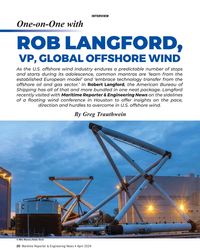 )
April 2024 - Maritime Reporter and Engineering News page: 20
)
April 2024 - Maritime Reporter and Engineering News page: 20INTERVIEW One-on-One with ROB LANGFORD, VP, GLOBAL OFFSHORE WIND As the U.S. offshore wind industry endures a predictable number of stops and starts during its adolescence, common mantras are ‘learn from the established European model’ and ‘embrace technology transfer from the offshore oil and gas
-
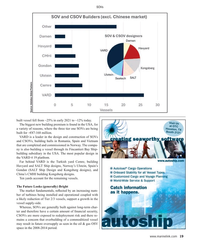 )
April 2024 - Maritime Reporter and Engineering News page: 19
)
April 2024 - Maritime Reporter and Engineering News page: 19SOVs Source: Intelatus Global Partners built vessel fell from ~25% in early 2021 to ~12% today. Visit Us The biggest new building premium is found in the USA, for at OTC Houston, TX a variety of reasons, where the three tier one SOVs are being Booth 2121 built for ~€87-168 million. VARD is a leader in
-
 )
April 2024 - Maritime Reporter and Engineering News page: 18
)
April 2024 - Maritime Reporter and Engineering News page: 18MARKETS & gas activity returns, we anticipate that supply of the vessels The Question of Emissions to offshore wind projects will reduce, driving demand for ad- Given that SOVs and CSOVs operate in a segment target- ditional CSOVs. ing reduced emissions, and many operate in the North Eu- Outside of China
-
 )
April 2024 - Maritime Reporter and Engineering News page: 16
)
April 2024 - Maritime Reporter and Engineering News page: 16MARKETS SOVs – Analyzing Current, Future Demand Drivers By Philip Lewis, Director of Research, Intelatus © Björn Wylezich/AdobeStock t a high-level, there are three solutions to transferring Lower day rate CTVs are often used for daily transfer of technicians from shore bases to offshore wind farms
-
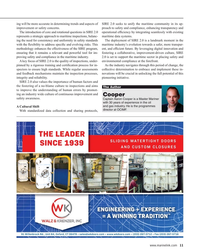 )
April 2024 - Maritime Reporter and Engineering News page: 11
)
April 2024 - Maritime Reporter and Engineering News page: 11ing will be more accurate in determining trends and aspects of SIRE 2.0 seeks to unify the maritime community in its ap- improvement or safety concerns. proach to safety and compliance, enhancing transparency and The introduction of core and rotational questions in SIRE 2.0 operational ef? ciency by
-
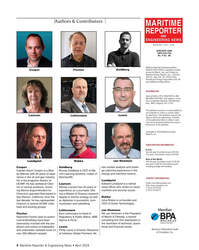 )
April 2024 - Maritime Reporter and Engineering News page: 4
)
April 2024 - Maritime Reporter and Engineering News page: 4Authors & Contributors MARITIME REPORTER AND ENGINEERING NEWS M A R I N E L I N K . C O M ISSN-0025-3448 USPS-016-750 No. 4 Vol. 86 Maritime Reporter/Engineering News (ISSN # 0025-3448) is published monthly Cooper Fischer Goldberg except for March, July, and October by Maritime Activity Reports, Inc.
-
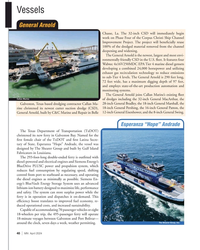 )
April 2024 - Marine News page: 40
)
April 2024 - Marine News page: 40Vessels General Arnold Chasse, La. The 32-inch CSD will immediately begin work on Phase Four of the Corpus Christi Ship Channel Improvement Project. The project will bene? cially reuse 100% of the dredged material removed from the channel deepening and widening. The General Arnold is the newest,
-
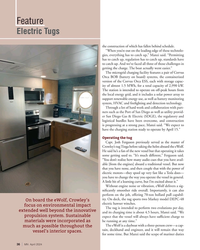 )
April 2024 - Marine News page: 36
)
April 2024 - Marine News page: 36Feature Electric Tugs the construction of which has fallen behind schedule. “When you’re out on the leading edge of these technolo- gies, everything has to catch up,” Manzi said. “Permitting has to catch up, regulation has to catch up, standards have to catch up. And we’ve faced all three of those challenge
-
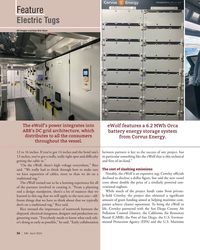 )
April 2024 - Marine News page: 34
)
April 2024 - Marine News page: 34Feature Electric Tugs All images courtesy Eric Haun The eWolf’s power integrates into eWolf features a 6.2 MWh Orca ABB’s DC grid architecture, which battery energy storage system distributes to all the consumers from Corvus Energy. throughout the vessel. 12 to 16 inches. If you’ve got 14 inches and
-
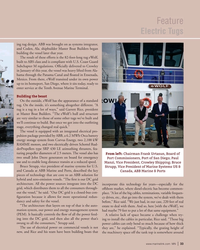 )
April 2024 - Marine News page: 33
)
April 2024 - Marine News page: 33Feature Electric Tugs ing tug design. ABB was brought on as systems integrator, and Coden, Ala. shipbuilder Master Boat Builders began building the vessel later that year. The result of these efforts is the 82-foot-long tug eWolf, built to ABS class and is compliant with U.S. Coast Guard Subchapter M
-
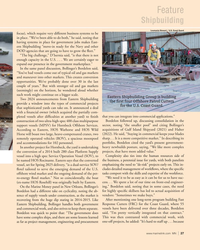 )
April 2024 - Marine News page: 27
)
April 2024 - Marine News page: 27Feature Shipbuilding Loumania Stewart / U.S. Coast Guard focus), which require very different business systems to be in place. “We’ve been able to do both,” he said, noting that having systems in place for government jobs makes East- ern Shipbuilding “move-in ready for the Navy and other DOD agencies
-
 )
February 2024 - Maritime Reporter and Engineering News page: 44
)
February 2024 - Maritime Reporter and Engineering News page: 44Tech Files Latest Products & Technologies MarineShaft Yanmar Hydrogen MarineShaft specializes in urgent re- Fuel Cell AIP pair/replacement of damaged rudder and Yanmar Power Technology Co., Ltd. propeller equipment along with many (Yanmar PT), a subsidiary of Yanmar on-site repair services. MarineShaft
-
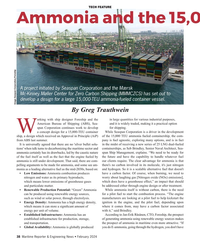 )
February 2024 - Maritime Reporter and Engineering News page: 38
)
February 2024 - Maritime Reporter and Engineering News page: 38TECH FEATURE Ammonia and the 15,00 A project initiated by Seaspan Corporation and the Mærsk Mc-Kinney Møller Center for Zero Carbon Shipping (MMMCZCS) has set out to develop a design for a large 15,000-TEU ammonia-fueled container vessel. Image Seaspan Corporation/Foreship By Greg Trauthwein orking with
